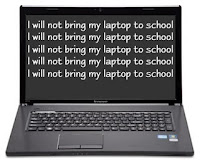 As if we needed another...education has a new acronym: BYOD (Bring Your Own Device). The topic is one of the hottest for educational technology as we begin 2012. The concept is simple: students bring their own devices from home to use in the classroom. The proponents believe it leverages already owned technology, saves districts money, and creates the long awaited, highly regarded one-to-one environment more quickly. The opponents believe it will further widen the digital divide, encourage inferior devices such as phones to replace computers, and let school officials off the hook when it comes to investing in the lives and learning of students. I think the successful solution lies smack in the middle...doesn't it always?
As if we needed another...education has a new acronym: BYOD (Bring Your Own Device). The topic is one of the hottest for educational technology as we begin 2012. The concept is simple: students bring their own devices from home to use in the classroom. The proponents believe it leverages already owned technology, saves districts money, and creates the long awaited, highly regarded one-to-one environment more quickly. The opponents believe it will further widen the digital divide, encourage inferior devices such as phones to replace computers, and let school officials off the hook when it comes to investing in the lives and learning of students. I think the successful solution lies smack in the middle...doesn't it always?The trend in personal mobile computing ownership is astounding, and one that can't be ignored. Freely accessible wifi is the new norm, and districts are under increasing pressure to make it available. Students and staff are already bringing their own devices (and their own networks) so it is just a matter of time before school administrators have to deal with the issue head on.
There's no doubt that an overnight policy change to permit students to bring in "any old device" would be nothing short of a train wreck. Platform inconsistencies, those who can afford vs. those who can't, network support issues, the list goes on...hopefully no one is suggesting, or attempting, that maneuver. There is, however, room for a sensible approach to BYOD...at least for those districts that have considered a one-to-one environment but couldn't afford it. Here are some important things to consider:
Defining "Device"
What is a device anyway? Gary Stager makes a relevant, and humorous, point on this here, but names and semantics aside, let's face it, students need substantial computing power and adequate screen size to create, produce, design, and program. And while I DO think smart phones should be allowed in schools and CAN enhance learning through communication and access...netbooks, tablets, and laptops are far better mobile "learning" devices.
Everyone Gets a Computer
Without a plan to put a computer in the hands of all students, you'll surely complicate instruction, frustrate teachers, further expose financial inequity, and be in a worse position than before you started. For those students who can't afford a computer, districts should develop financial assistance programs and leverage volume purchase plans to make units available at little or no cost. As compared to a full fledged one-to-one program, districts will realize savings for not having to buy computers for the students who already own them (or who can afford to buy them). And yes, it goes without saying, the financial burden shifts from parents to the district in communities with higher rates of poverty.
Setting Standards
Just like the standards that are set for school supplies or sports equipment, a minimum spec for computers is needed too. Standards for browsers, OS, and desktop publishing should be discussed...keeping in mind the reality of the web 2.0 world we live in. Many applications have moved from client-based to the web, and the vast majority of laptop and tablet devices connect in the same way, despite browser and OS differences. The need for computer labs may still exist of course, especially for dedicated applications such as those found in architecture, art, and programming. That said, the use of virtual computing is now a practical and affordable solution for delivering a traditional desktop with client-based applications to tablets and laptops alike. VDI (virtual desktop infrastructure) is very promising in a BYOD model since it allows for platform and application uniformity (regardless of device), and lets network administrators sleep well at night knowing that personal devices aren't infiltrating the school network. A good article here explains the growing relationship of VDI and BYOD.
Network Support
School districts should provide a robust, filtered, and fully accessible wireless network, but I don't think they should support personal devices. There, I said it. Districts can support the computers they provide, but the students who own laptops and phones find ways to fix and update them now...and that doesn't need to change. The school motto should be..."we expect all students to come prepared for learning with a mobile computer that meets our minimum requirements, and if a family can't afford one, financial assistance is available." We say it for so many other things, why not computers?
The convergence of mobile devices, wireless networks, and the continued evolution of the Internet has opened new doors for learning. Let's take advantage of the opportunity by leveraging personal technology in the classroom, the same way it is being done on college campuses and in the workplace. Combining the frameworks of BYOD and one-to-one computing seems like a logical first step.